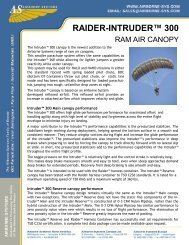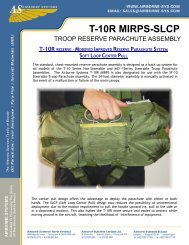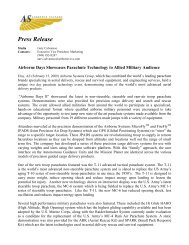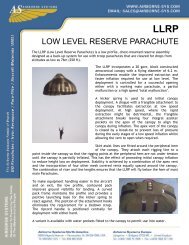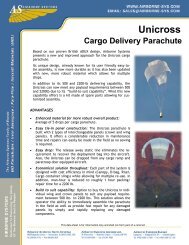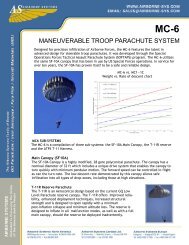AIAA-1999-1707 Design and Testing of the - Airborne Systems
AIAA-1999-1707 Design and Testing of the - Airborne Systems
AIAA-1999-1707 Design and Testing of the - Airborne Systems
Create successful ePaper yourself
Turn your PDF publications into a flip-book with our unique Google optimized e-Paper software.
*<br />
Manager, Technical Development<br />
Lead Engineer<br />
Senior Project Engineer<br />
<strong>AIAA</strong>-99-<strong>1707</strong><br />
DESIGN AND TESTING OF THE KISTLER LANDING SYSTEM PARACHUTES<br />
Anthony P. Taylor * , Robert J. Sinclair , Richard D. Allamby, M.B.E.<br />
Irvin Aerospace Inc., Santa Ana, California 92704<br />
The Kistler L<strong>and</strong>ing system consists <strong>of</strong> parachutes <strong>and</strong> airbags to l<strong>and</strong> both stages <strong>of</strong> <strong>the</strong> Kistler<br />
Aerospace, K-1 Reusable Launch Vehicle. The K-1 Reusable Launch Vehicle is a commercial<br />
venture to develop <strong>the</strong> worlds first fully re-usable launch vehicle. The unmanned launcher<br />
consists <strong>of</strong> two stages, <strong>the</strong> first or Launch Assist Platform (LAP), <strong>and</strong> <strong>the</strong> second stage, or<br />
Orbital Vehicle (OV). This paper presents an update on <strong>the</strong> status <strong>of</strong> parachute testing for <strong>the</strong><br />
Kistler program.<br />
Introduction<br />
The Kistler L<strong>and</strong>ing system consists <strong>of</strong> parachutes <strong>and</strong><br />
airbags to l<strong>and</strong> both stages <strong>of</strong> <strong>the</strong> Kistler Aerospace,<br />
K-1 Reusable Launch Vehicle. The K-1 Reusable<br />
Launch Vehicle is a commercial venture to develop <strong>the</strong><br />
worlds first fully re-usable launch vehicle. The<br />
unmanned launcher consists <strong>of</strong> two stages, <strong>the</strong> first or<br />
Launch Assist Platform (LAP), <strong>and</strong> <strong>the</strong> second stage, or<br />
Orbital Vehicle (OV).<br />
Following staging, <strong>the</strong> LAP performs a return to launch<br />
site maneuver <strong>and</strong> is <strong>the</strong>n recovered for a s<strong>of</strong>t earth<br />
l<strong>and</strong>ing using parachutes <strong>and</strong> airbags. Recovery <strong>of</strong> <strong>the</strong><br />
nearly 45,000 lb vehicle is accomplished with a drogue<br />
<strong>and</strong> main stage, followed by an airbag attenuated<br />
impact. The drogue stage consists <strong>of</strong> two 40.0 ft conical<br />
ribbon parachutes, similar in design to <strong>the</strong> shuttle<br />
orbiter parabrake. The main stage consists <strong>of</strong> six (6),<br />
156.0 ft. diameter ring sail parachutes. These<br />
parachutes are rigged in two clusters <strong>of</strong> three<br />
parachutes. Figure1 presents a graphical depiction <strong>of</strong><br />
<strong>the</strong> LAP recovery sequence.<br />
Following re-entry, <strong>the</strong> OV is stabilized, decelerated,<br />
<strong>and</strong> recovered using parachutes <strong>and</strong> airbags. Due to its<br />
limited static stability at low super-sonic Mach, <strong>the</strong> first<br />
parachute deployed is a stabilization parachute, which<br />
maintains vehicle stability during deceleration.<br />
Following stabilization parachute deployment, a drogue<br />
stage parachute is deployed to fur<strong>the</strong>r decelerate, <strong>and</strong><br />
prepare for main cluster deployment. The main canopy<br />
cluster <strong>of</strong> three (3) parachutes provides <strong>the</strong> correct<br />
l<strong>and</strong>ing velocity for airbag attenuated impact.<br />
Parachutes for this recovery consist <strong>of</strong> a 23.0 ft<br />
hemisflo parachute, <strong>of</strong> all Kevlar construction, a 40.0 ft<br />
conical ribbon drogue, identical to <strong>the</strong> two parachutes<br />
used in <strong>the</strong> LAP drogue stage, <strong>and</strong> three (3) 156.0 ft.<br />
ring sail parachutes, also identical to <strong>the</strong> LAP main<br />
stage.<br />
Figure 1<br />
Parachute commonality, where possible was maintained<br />
to reduce development, testing, <strong>and</strong> overall program<br />
costs. Figure 2 presents a graphical representation <strong>of</strong><br />
<strong>the</strong> OV recovery sequence.
Figure 2<br />
This paper presents an overview <strong>of</strong> <strong>the</strong> parachute<br />
design, testing approach, test program details, including<br />
lessons learned, <strong>and</strong> an overview <strong>of</strong> <strong>the</strong> test results.<br />
Stabilizing Drogue Parachute<br />
The Hemisflo Parachute was chosen for <strong>the</strong> Kistler<br />
Stabilizing Drogue due to it’s extensive design pedigree<br />
as a supersonic stabilization ‘chute. The size <strong>of</strong> 23 ft Do<br />
was selected following analysis <strong>of</strong> aerodynamic, CG<br />
<strong>and</strong> Orbital Vehicle wake CFD. The Kistler Stabilizer<br />
proved to be a very challenging design activity as it is<br />
one <strong>of</strong> <strong>the</strong> largest supersonic Hemisflo type parachutes<br />
ever attempted. The major driver in <strong>the</strong> design <strong>and</strong><br />
construction definition was <strong>the</strong> supersonic flight<br />
environment. The start conditions for deployment are<br />
M=2.5 at an altitude <strong>of</strong> 80,000 feet MSL. This provides<br />
2<br />
American Institute <strong>of</strong> Aeronautics <strong>and</strong> Astronautics<br />
<strong>AIAA</strong>-99-<strong>1707</strong><br />
a supersonic flight time <strong>of</strong> some 23 seconds, a very<br />
dem<strong>and</strong>ing flight regime. Consideration was especially<br />
given to <strong>the</strong> Stagnation Temperature <strong>and</strong> Ribbon Flutter<br />
problems that would be encountered during <strong>the</strong> OV<br />
stabilization phase <strong>of</strong> <strong>the</strong> mission.<br />
The parachute geometry was based on previous<br />
Hemisflo data <strong>and</strong> is defined as follows:<br />
- Included hemispherical angle 210 o<br />
- Number <strong>of</strong> Gores 40<br />
- Number <strong>of</strong> Horizontals per Gore 49<br />
- Number <strong>of</strong> Verticals per Gore 3<br />
- Geometric porosity 15.5%<br />
Porosity selection for <strong>the</strong> Hemisflo must be <strong>of</strong> an order<br />
that ensures positive inflation stability <strong>and</strong> reasonable<br />
parachute flight stability. Previous research (reference<br />
1) has indicated that too high a porosity value will lead<br />
to inflation instability during flight <strong>and</strong> if <strong>the</strong> total<br />
porosity exceeds some 30 % <strong>the</strong> parachute may fail to<br />
inflate at <strong>the</strong> local Mach number <strong>of</strong> 2.5. Conversely if<br />
<strong>the</strong> parachute porosity is too low, violent oscillatory<br />
motions are observed during flight <strong>and</strong> <strong>the</strong>se may have<br />
a de-stabilizing effect on <strong>the</strong> vehicle. The porosity<br />
selected for <strong>the</strong> OV Stabilizer was aimed at <strong>the</strong> lower<br />
end <strong>of</strong> <strong>the</strong> envelope presented at reference 1, as<br />
inflation stability is obviously essential for <strong>the</strong> mission<br />
<strong>and</strong> any parachute oscillations would be partially decoupled<br />
from <strong>the</strong> vehicle by <strong>the</strong> long parachute riser.<br />
The unknown Stagnation Temperature effects to which<br />
<strong>the</strong> Stabilizer will be subject also gave <strong>the</strong> designers<br />
some concern. To this end it was decided to construct<br />
<strong>the</strong> parachute entirely from high temperature materials.<br />
Except for <strong>the</strong> Vent B<strong>and</strong>, which is Nomex, <strong>the</strong> entire<br />
parachute is manufactured from Para-Aramid (Kevlar)<br />
materials. Nomex was selected for <strong>the</strong> Vent B<strong>and</strong> as it<br />
has similar elongation properties to nylon <strong>and</strong> would<br />
<strong>the</strong>refore provide similar load relief. Following this<br />
decision for <strong>the</strong> parachute design methodology, detailed<br />
<strong>the</strong>rmodynamic analysis has justified this conservative<br />
approach.<br />
Horizontal Ribbon trailing edge flutter is a serious<br />
concern with a supersonic flight time <strong>of</strong> this length. In<br />
order to protect <strong>the</strong> fabric from mechanical damage<br />
from flutter effects, special ribbons were developed.<br />
These all Kevlar ribbons incorporated triple selvage<br />
construction to provide a very robust leading <strong>and</strong><br />
trailing edge. This specially developed ribbon did cause<br />
manufacturing problems. A very complex joint was<br />
required to achieve adequate efficiency. This precluded<br />
<strong>the</strong> option <strong>of</strong> manufacturing <strong>the</strong> parachute using cut
gore techniques. The parachute was <strong>the</strong>refore designed<br />
as a continuous ribbon.<br />
The parachute is Skirt Rigged <strong>and</strong> employs circular<br />
braided cord as a suspension line material. Circular<br />
cord is used to minimize suspension line wake effects<br />
<strong>and</strong> <strong>the</strong>y are connected to <strong>the</strong> parachute riser directly<br />
thus obviating <strong>the</strong> requirement for a mechanical<br />
interconnector with it’s associated weight penalty.<br />
Drogue Parachute<br />
The Variable Porosity Conical Ribbon (VPCR) was<br />
selected for <strong>the</strong> LAP <strong>and</strong> OV Drogue Parachutes. The<br />
size <strong>of</strong> <strong>the</strong> Drogues was established to provide<br />
commonality between <strong>the</strong> two vehicles <strong>and</strong> to provide<br />
<strong>the</strong> required deployment conditions for <strong>the</strong> Main<br />
Parachutes. The parachute geometry was based on <strong>the</strong><br />
Shuttle Parabrake <strong>and</strong> is defined as follows:<br />
- Reference Diameter Do 40.3 ft<br />
- Number <strong>of</strong> Gores 40<br />
- Number <strong>of</strong> Horizontals per gore 92<br />
- Number <strong>of</strong> Verticals per Gore 7<br />
- Geometric Porosity 16.1%<br />
Porosity selection for <strong>the</strong> parachute was derived from<br />
wind tunnel data collected by S<strong>and</strong>ia during <strong>the</strong> Orbiter<br />
Drag Chute Stability Tests in <strong>the</strong> NASA/Ames 80 x 120<br />
Foot Wind Tunnel (reference 2). During this test<br />
campaign <strong>the</strong> original planform <strong>of</strong> <strong>the</strong> parachute was<br />
modified by <strong>the</strong> removal <strong>of</strong> ribbons from <strong>the</strong> shoulder<br />
<strong>and</strong> crown regions <strong>of</strong> <strong>the</strong> canopy. The resulting<br />
planform <strong>and</strong> geometric porosity <strong>of</strong> 16.1% proved<br />
extremely stable <strong>and</strong> was <strong>the</strong>refore selected for <strong>the</strong><br />
Kistler drogue 'chutes.<br />
Both <strong>the</strong> OV <strong>and</strong> LAP flight pr<strong>of</strong>iles require reefing<br />
stages. To ensure reliable reefed inflation, <strong>the</strong> design<br />
departed from <strong>the</strong> common 1% So vent area <strong>and</strong><br />
reduced <strong>the</strong> size to a figure <strong>of</strong> 0.29% So. This ensures<br />
that <strong>the</strong> parachute achieves repeatable <strong>and</strong> reliable<br />
crown pressurization. The design <strong>of</strong> <strong>the</strong> reefing assets<br />
include specially designed dual reefing rings. These<br />
have been sized to give optimum reefing line control<br />
<strong>and</strong> minimize skirt bulk.<br />
The parachute has 1.2 Do suspension lines that are fully<br />
rigged onto <strong>the</strong> canopy <strong>and</strong> form <strong>the</strong> radial tapes <strong>and</strong><br />
vent lines. Inner radials wrap around <strong>the</strong> suspension<br />
lines at <strong>the</strong> skirt plane to eliminate peeling. The lines<br />
are terminated at an Aluminum ring in <strong>the</strong> vent. This<br />
ring ensures no mechanical interaction occurs between<br />
3<br />
American Institute <strong>of</strong> Aeronautics <strong>and</strong> Astronautics<br />
<strong>AIAA</strong>-99-<strong>1707</strong><br />
<strong>the</strong> vent lines which is known to cause abrasion damage<br />
in Kevlar materials, especially in re-useable systems.<br />
The parachute is designed as a cut gore ribbon to ease<br />
manufacture. This also minimizes trailing edge fullness,<br />
<strong>and</strong> <strong>the</strong>refore flutter, in <strong>the</strong> horizontals.<br />
Main Parachute<br />
The Kistler Main Parachute is made up <strong>of</strong> 5 rings <strong>and</strong><br />
10 sails <strong>and</strong> has a reference diameter (Do) <strong>of</strong> 156 ft.<br />
The canopy consists <strong>of</strong> 19113 square feet <strong>of</strong> drag<br />
producing surface. The parachute incorporates a Kevlar<br />
structural grid <strong>and</strong> a nylon drag-producing surface. The<br />
Irvin ¼ spherical Ringsail planform was selected due to<br />
it’s excellent stability characteristics, reefed<br />
performance <strong>and</strong> high drag coefficient.<br />
The parachute derives it’s exceptional performance<br />
from <strong>the</strong> true ¼ spherical geometry, fullness<br />
distribution <strong>and</strong> porosity distribution. Drag is fur<strong>the</strong>r<br />
enhanced by <strong>the</strong> use <strong>of</strong> 1.15 Do suspension lines. The<br />
canopy is made up <strong>of</strong> 112 gores <strong>and</strong> each panel is sized<br />
to employ full width fabric. The suspension lines are<br />
Larkshead attached to <strong>the</strong> radials at <strong>the</strong> skirt plane <strong>and</strong><br />
terminated on steel 6K links at <strong>the</strong> riser. This allows<br />
rapid change out <strong>of</strong> damaged lines, a feature essential to<br />
<strong>the</strong> re-usability <strong>of</strong> <strong>the</strong> system.<br />
The most significant feature that has been developed<br />
during <strong>the</strong> Kistler main parachute design phase is <strong>the</strong><br />
deployment control. Very large descent class<br />
parachutes <strong>of</strong> this type are generally problematical in<br />
clusters apropos load sharing. The design goal during<br />
development was to eliminate, as far as possible,<br />
lead/lag within <strong>the</strong> cluster <strong>and</strong> to reduce 1 st stage<br />
inflation damage caused by <strong>the</strong> formation <strong>of</strong> false<br />
apexes in <strong>the</strong> individual canopies. Three very important<br />
features were built into <strong>the</strong> design <strong>of</strong> <strong>the</strong> deployment<br />
system <strong>and</strong> performed exceptionally well during test.<br />
Deployment Bag <strong>Design</strong><br />
The deployment bags for <strong>the</strong> 3 ‘chute OV cluster <strong>and</strong><br />
<strong>the</strong> 6 ‘chute LAP cluster incorporate a lacing system<br />
that allows <strong>the</strong> bags to be tied toge<strong>the</strong>r <strong>and</strong> deployed as<br />
one. This feature ensures that <strong>the</strong> canopy skirts all break<br />
out <strong>of</strong> <strong>the</strong> bags toge<strong>the</strong>r. This ensures that canopy<br />
filling begins simultaneously. The deployment bags<br />
also incorporate multiple stowage flaps to control <strong>the</strong><br />
egress <strong>of</strong> <strong>the</strong> risers <strong>and</strong> suspension lines at <strong>the</strong> 250 fps<br />
deployment velocity.
Vent Leash <strong>Design</strong><br />
It is common practice to attach <strong>the</strong> vent <strong>of</strong> a parachute<br />
to <strong>the</strong> deployment bag by some means <strong>of</strong> break tie.<br />
These ties usually serve <strong>the</strong> purpose <strong>of</strong> tensioning <strong>the</strong><br />
structural grid during <strong>the</strong> initial filling <strong>of</strong> <strong>the</strong> canopy.<br />
With a canopy <strong>the</strong> size <strong>of</strong> <strong>the</strong> Kistler main ‘chute this<br />
method <strong>of</strong> vent control is inadequate. The Kistler main<br />
parachute incorporates an incremental bridle that has an<br />
average tear force <strong>of</strong> 400 lbs <strong>and</strong> a stroke <strong>of</strong> 140 feet.<br />
This bridle applies sufficient tension to <strong>the</strong> structural<br />
grid <strong>of</strong> <strong>the</strong> canopy to keep it taut during <strong>the</strong> entire preinflation<br />
phase <strong>and</strong> through to crown pressurization.<br />
The vent leash ensures that <strong>the</strong> “ball <strong>of</strong> air” entering <strong>the</strong><br />
canopy impacts centrally at <strong>the</strong> vent area. It also<br />
ensures inflation uniformity within <strong>the</strong> cluster, which<br />
greatly reduces any lead/lag factors.<br />
Sacrifice Panel <strong>Design</strong><br />
The Kistler main parachute incorporates a sacrifice<br />
panel that engulfs <strong>the</strong> entire length <strong>of</strong> canopy. After <strong>the</strong><br />
canopy has been long folded, <strong>the</strong> sacrifice panel is<br />
wrapped around it <strong>and</strong> whipped stitched closed. The<br />
sacrifice panel serves two very important functions<br />
during <strong>the</strong> pre-inflation phase <strong>of</strong> deployment. Firstly it<br />
serves as a protective sleeve as <strong>the</strong> canopy is being<br />
stripped from <strong>the</strong> deployment bag at high speed.<br />
Secondly, <strong>the</strong> resistance <strong>of</strong> <strong>the</strong> sacrifice panel unfurling<br />
as <strong>the</strong> air moves towards <strong>the</strong> vent <strong>of</strong> <strong>the</strong> canopy<br />
effectively gives <strong>the</strong> canopy a “moving vent”. The<br />
effect <strong>of</strong> this phenomenon is to maintain an even skirt<br />
plane during <strong>the</strong> entire pre-inflation phase, this<br />
drastically improves inlet formation <strong>and</strong> first stage<br />
inflation.<br />
The parachutes have demonstrated exceptional<br />
performance during <strong>the</strong> test program <strong>and</strong> <strong>the</strong> measures<br />
taken to improve <strong>the</strong> cluster performance have proved<br />
to be essential deployment aids in canopies <strong>of</strong> this<br />
magnitude.<br />
Development <strong>Testing</strong><br />
The challenge <strong>of</strong> developing a launch system under<br />
commercial funding leads to compromises in <strong>the</strong><br />
number <strong>and</strong> type <strong>of</strong> tests that can be performed. Also<br />
commercial factors such as time scales <strong>and</strong> <strong>the</strong> funds<br />
available for development must be taken into account<br />
from <strong>the</strong> outset. Development testing <strong>of</strong> not less than 5<br />
unique parachute configurations is planned, as well as<br />
single parachute tests to establish a performance<br />
baseline.<br />
4<br />
American Institute <strong>of</strong> Aeronautics <strong>and</strong> Astronautics<br />
<strong>AIAA</strong>-99-<strong>1707</strong><br />
The two main parachute clusters, <strong>and</strong> several single<br />
parachute tests have been completed to date. At <strong>the</strong><br />
time <strong>of</strong> writing, <strong>the</strong> stabilization <strong>and</strong> drogue parachutes<br />
have not been tested, but significant engineering <strong>and</strong><br />
development has lead to parachute test configuration<br />
definition.<br />
Additionally, <strong>the</strong> sheer size <strong>of</strong> <strong>the</strong> vehicle stages<br />
reduces what is feasible in a reasonable parachute drop<br />
test environment. As a result, unique control <strong>and</strong><br />
rigging techniques were developed to adapt existing<br />
equipment to meet <strong>the</strong> challenges presented. These<br />
included:<br />
• Stabilization techniques to control Type V<br />
platform/load tub combinations during load<br />
extraction, accelerations <strong>and</strong> test parachute<br />
deployment.<br />
• Timed release <strong>of</strong> extraction parachutes to ensure<br />
realistic mains deployment conditions.<br />
• Mounting <strong>of</strong> 6 large parachutes for delayed<br />
deployment from a platform/load tub<br />
combination.<br />
• Unique rigging to allow simulation <strong>of</strong> vehicle<br />
attitude re-orientation.<br />
• Modification <strong>of</strong> a large CTV to allow recovery<br />
<strong>of</strong> <strong>the</strong> test vehicle following drogue parachute<br />
testing.<br />
Test Rationale<br />
Due to funding <strong>and</strong> time scale restrictions it became<br />
clear from <strong>the</strong> outset that testing all corners <strong>of</strong> each<br />
system envelope would not be possible. To this end a<br />
program rationale was agreed that would attempt to test<br />
each system at a baseline condition, an optimized<br />
baseline condition <strong>and</strong> <strong>the</strong>n at a pro<strong>of</strong> load condition. If<br />
optimization or modification were felt to be<br />
unnecessary after <strong>the</strong> baseline drop <strong>the</strong>n <strong>the</strong> optimized<br />
drop would not be conducted. This rationale has proved<br />
a feasible way forward to date.<br />
During <strong>the</strong> program it was decided to add an additional<br />
test in an effort to review a major area <strong>of</strong> concern. This<br />
test was designed to simulate vehicle attitude reorientation<br />
<strong>and</strong> required <strong>the</strong> application <strong>of</strong> test specific,<br />
unique load rigging techniques.
Test Time Scales <strong>and</strong> Funding<br />
As stated above, due to <strong>the</strong> commercial nature <strong>of</strong> this<br />
program <strong>the</strong> development testing had to be carefully<br />
planned to make best use <strong>of</strong> <strong>the</strong> time <strong>and</strong> funds<br />
available. It became clear from <strong>the</strong> start <strong>of</strong> discussions<br />
with Yuma Proving Ground (YPG) personnel <strong>and</strong> after<br />
looking at commercial aircraft options that <strong>the</strong> best,<br />
fastest <strong>and</strong> most cost effective option was to use<br />
military aircraft.<br />
Once this option was agreed upon it became clear that<br />
to make best use <strong>of</strong> military assets <strong>the</strong> test loads would<br />
need to be loaded <strong>and</strong> extracted from <strong>the</strong> aircraft using<br />
st<strong>and</strong>ard military parachutes <strong>and</strong> procedures.<br />
Therefore every test conducted used st<strong>and</strong>ard Type V<br />
Platforms, st<strong>and</strong>ard load extraction techniques <strong>and</strong> most<br />
importantly <strong>the</strong> correct type <strong>of</strong> extractor parachute for<br />
<strong>the</strong> load mass being tested. This approach at times<br />
meant minor modifications to test procedures but this<br />
by far outweighed <strong>the</strong> advantages afforded by<br />
employing st<strong>and</strong>ard techniques. This approach had <strong>the</strong><br />
following advantages:<br />
• Lengthy proposed test plan (PTP) clearance was<br />
not required.<br />
• Additional testing to ensure <strong>the</strong> safety <strong>of</strong> test<br />
specific load extraction techniques was not<br />
required.<br />
• Any airdrop compatible aircraft could be used to<br />
drop <strong>the</strong> test loads.<br />
• Any airdrop trained military aircrew could fly <strong>the</strong><br />
test mission.<br />
This approach enabled 10 tests to be conducted in 9<br />
months.<br />
Test Loads<br />
<strong>Testing</strong> to date has been by <strong>the</strong> use <strong>of</strong> Type V platforms<br />
<strong>and</strong> ballast load tubs. Load tubs were rigged onto<br />
platforms using st<strong>and</strong>ard rigging techniques <strong>and</strong> <strong>the</strong><br />
st<strong>and</strong>ard Extraction Force Transfer Coupling (EFTC)<br />
system was used for load extraction <strong>and</strong> parachute<br />
release. Test parachutes were mounted on <strong>the</strong> aft end <strong>of</strong><br />
<strong>the</strong> load, see Figure 3 <strong>and</strong> deployed by <strong>the</strong> extractor<br />
parachute following extraction from <strong>the</strong> aircraft <strong>and</strong><br />
EFTC release.<br />
To simulate realistic deployment <strong>of</strong> <strong>the</strong> main parachutes<br />
<strong>the</strong> extractor parachutes remained connected to <strong>the</strong><br />
platform, see Figures 4 <strong>and</strong> 5, for a specified period<br />
after extraction. This allowed <strong>the</strong> load to reach <strong>the</strong><br />
5<br />
American Institute <strong>of</strong> Aeronautics <strong>and</strong> Astronautics<br />
Figure 3<br />
<strong>AIAA</strong>-99-<strong>1707</strong><br />
desired velocity prior to <strong>the</strong> deployment <strong>of</strong> <strong>the</strong> main<br />
parachutes. To achieve this <strong>the</strong> EFTC activation arm<br />
was secured in position with a nylon cord tie. Two<br />
static line initiated, timed reefing line cutters were used<br />
to cut this tie, after <strong>the</strong> specified time delay, <strong>the</strong>reby<br />
releasing <strong>the</strong> EFTC activation drop arm. Activation <strong>of</strong><br />
<strong>the</strong> drop arm released <strong>the</strong> extractor parachute, which<br />
initiated deployment <strong>of</strong> <strong>the</strong> main test parachutes see<br />
Figure 6.<br />
Figure 4<br />
Load Release <strong>and</strong> Transfer<br />
On <strong>the</strong> first test <strong>the</strong> st<strong>and</strong>ard military drop technique<br />
was used. This entails <strong>the</strong> load transferring from a<br />
vertical to a horizontal orientation as <strong>the</strong> main<br />
parachutes are deploying. This system worked well for<br />
<strong>the</strong> first drop, however on <strong>the</strong> second drop <strong>the</strong> load cut<br />
one <strong>of</strong> <strong>the</strong> main suspension risers as it transferred. This<br />
caused a cascade failure <strong>of</strong> <strong>the</strong> remainder <strong>of</strong> <strong>the</strong><br />
suspension system <strong>and</strong> <strong>the</strong> load broke free from <strong>the</strong><br />
main parachutes. Following analysis <strong>of</strong> <strong>the</strong> test video it<br />
became apparent that <strong>the</strong> platform <strong>and</strong> load were<br />
aerodynamically every unstable as <strong>the</strong> main parachutes<br />
deployed. This was due to <strong>the</strong> fact that <strong>the</strong> load was
effectively in free fall for<br />
some 400 ft between<br />
extractor parachute<br />
release <strong>and</strong> stabilization<br />
by <strong>the</strong> drag <strong>of</strong> <strong>the</strong><br />
deploying main<br />
parachutes.<br />
To overcome this<br />
problem it was agreed<br />
that <strong>the</strong> platform needed<br />
to be stabilized during<br />
mains deployment, see<br />
Figure 6 <strong>and</strong> that load<br />
transfer should not take<br />
place as this made <strong>the</strong><br />
platform very unstable.<br />
Load instability was<br />
addressed <strong>and</strong> cured by <strong>the</strong> addition <strong>of</strong> stabilization<br />
parachutes <strong>and</strong> <strong>the</strong> negation <strong>of</strong> load transfer.<br />
The remainder <strong>of</strong> loads were dropped using this<br />
technique <strong>and</strong> no fur<strong>the</strong>r instability problems were<br />
encountered. The use <strong>of</strong> this technique required <strong>the</strong><br />
following load modifications:<br />
• Streng<strong>the</strong>ning <strong>of</strong> <strong>the</strong> aft end <strong>of</strong> <strong>the</strong> load tub to<br />
ensure structural integrity during main parachute<br />
deployment.<br />
• Attachment <strong>of</strong> <strong>the</strong> extractor parachute to <strong>the</strong> load<br />
ra<strong>the</strong>r than <strong>the</strong> platform, <strong>the</strong>reby ensuring <strong>the</strong><br />
extraction pull was through <strong>the</strong> CG <strong>of</strong> <strong>the</strong> load <strong>and</strong><br />
less instability was initiated on extractor release.<br />
• The CG <strong>of</strong> <strong>the</strong> load was moved as far forward as<br />
possible to aid nose down stability, whilst<br />
remaining within <strong>the</strong> allowable CG limits for<br />
military aircraft.<br />
Six Parachute Load<br />
The six parachute test was <strong>the</strong> last <strong>of</strong> <strong>the</strong> current<br />
program to take place. The rigged load mass was<br />
42,000 lbs using an 18 ft long load tub on a 24 ft long<br />
Type V platform, see Figure 7. The simulate<br />
deployment <strong>of</strong> <strong>the</strong> 6 main parachutes from <strong>the</strong> Kistler<br />
vehicle a reproduction <strong>of</strong> <strong>the</strong> vehicle parachute<br />
retention canister was used.<br />
The canister was mounted on <strong>the</strong> aft end <strong>of</strong> <strong>the</strong> load tub<br />
<strong>and</strong> <strong>the</strong> six main parachutes were rigged into, <strong>and</strong><br />
deployed from, this structure, see Figure 8. Fur<strong>the</strong>r<br />
structural reinforcement <strong>of</strong> <strong>the</strong> load tub was required to<br />
withst<strong>and</strong> <strong>the</strong> predicted deployment forces <strong>and</strong> unique<br />
rigging techniques were used to ensure <strong>the</strong> correct<br />
Figure 5 Figure 6<br />
6<br />
American Institute <strong>of</strong> Aeronautics <strong>and</strong> Astronautics<br />
<strong>AIAA</strong>-99-<strong>1707</strong><br />
deployment <strong>of</strong> <strong>the</strong> 6<br />
main parachutes from <strong>the</strong><br />
parachute canister.<br />
This world record<br />
parachute configuration<br />
was dropped on <strong>the</strong> 23<br />
June 1998 from a C5<br />
aircraft at an altitude <strong>of</strong><br />
10,000 ft AGL, see<br />
Figure 9.<br />
Shock Drop<br />
The shock drop, as it<br />
became known, was an<br />
addition to <strong>the</strong> test<br />
program designed to<br />
simulate <strong>the</strong> forces generated by <strong>the</strong> re-orientation <strong>the</strong><br />
Kistler vehicle. This drop again required unique rigging<br />
techniques <strong>and</strong> test specific attachment <strong>and</strong> confluence<br />
fittings. The concept <strong>of</strong> <strong>the</strong> test was to deploy <strong>the</strong> main<br />
parachute, using <strong>the</strong> same technique as previous tests,<br />
<strong>and</strong> <strong>the</strong>n cut <strong>the</strong> primary suspension riser <strong>and</strong> allow <strong>the</strong><br />
load to drop 7 ft before being arrested by a secondary<br />
main riser.<br />
The cutting <strong>of</strong> <strong>the</strong> primary riser was initiated by a<br />
secondary EFTC actuation arm <strong>and</strong> cable mounted on<br />
<strong>the</strong> load tub. Activation <strong>of</strong> this cable was by two static<br />
line initiated, timed reefing cutters. These cutters<br />
released <strong>the</strong> actuation arm, which retracted <strong>the</strong> end <strong>of</strong><br />
<strong>the</strong> EFTC cable, this operation activated an electronic<br />
circuit which fired a pyrotechnic initiated harness<br />
cutter. This cut <strong>the</strong> primary suspension harness<br />
allowing <strong>the</strong> load to fall onto <strong>the</strong> secondary harness.<br />
Load cells in <strong>the</strong> main suspension system measured <strong>the</strong><br />
loads generated by <strong>the</strong> operation.<br />
Figure 7
Figure 8<br />
Test Results<br />
Several aspects <strong>of</strong> <strong>the</strong> parachute test program are<br />
presented in this section. We begin with a discussion <strong>of</strong><br />
<strong>the</strong> instrumentation, <strong>and</strong> its intent. Following this, some<br />
basic results from <strong>the</strong> drop test program are presented.<br />
These include:<br />
1) Single canopy test results which, demonstrate<br />
drag coefficients far in excess <strong>of</strong> 1.0.<br />
2) Cluster performance data for <strong>the</strong> three (3)<br />
parachute cluster is presented. Six parachute<br />
data is still under analysis at <strong>the</strong> time <strong>of</strong><br />
writing.<br />
3) Cluster Lead/Lag is presented for some cluster<br />
tests.<br />
4) Unique parachute inflation characteristics,<br />
including a lower first stage reefing ratio (than<br />
design), <strong>and</strong> a slower first stage inflation (than<br />
expected) are presented – both <strong>of</strong> <strong>the</strong>se lead to<br />
lower than expected loads.<br />
5) A unique test to assist in <strong>the</strong> determination <strong>of</strong><br />
parachute loads during stage attitude changes<br />
is presented.<br />
Test Instrumentation<br />
Drop tests conducted included full parachute system<br />
instrumentation, which was:<br />
- Time Space Position Information<br />
- Deployment trajectory <strong>and</strong> confirmation<br />
- Syn<strong>the</strong>sized airspeed during parachute<br />
deployment<br />
- Terminal Rate <strong>of</strong> Descent<br />
- Atmospheric data for wind <strong>and</strong> density correction<br />
- Test Vehicle Accelerations – primarily as a backup<br />
to parachute force measurements<br />
- Parachute Riser Force Measurements – for<br />
parachute inflation characteristics<br />
7<br />
American Institute <strong>of</strong> Aeronautics <strong>and</strong> Astronautics<br />
<strong>AIAA</strong>-99-<strong>1707</strong><br />
- For parachute cluster tests, both <strong>the</strong> individual<br />
parachutes, <strong>and</strong> <strong>the</strong> entire cluster were instrumented<br />
The reduction <strong>of</strong> <strong>the</strong>se data allows <strong>the</strong> analyst to study<br />
several key parachute characteristics. Primary among<br />
<strong>the</strong>se are; parachute inflation loads, reduction <strong>of</strong> loads<br />
into parachute inflation characteristic (CdS vs. time),<br />
<strong>and</strong> <strong>the</strong> parachute performance, or fully inflated<br />
parachute drag area (CdS).<br />
Single Canopy Performance<br />
Steady state rate <strong>of</strong> descent, indicates a parachute drag<br />
coefficient <strong>of</strong> more than 1.0, based on constructed<br />
diameter. Particularly at <strong>the</strong> lighter W/S which were<br />
tested. This is attributed to <strong>the</strong> high performance<br />
construction techniques employed. This high canopy<br />
performance <strong>and</strong> <strong>the</strong> light weight construction afforded<br />
by Nylon/Kevlar construction are consistent with <strong>the</strong><br />
space weight design requirements <strong>of</strong> <strong>the</strong> Kistler<br />
Program.<br />
Figure 9<br />
Figure 10 presents single canopy rate <strong>of</strong> descent for a<br />
single canopy drop. The suspended weight for this drop<br />
was 7330, which is lighter than <strong>the</strong> design criteria. The<br />
data presented are corrected to Sea level density for all
Cd<br />
flight altitudes. Test range data include density versus<br />
altitude measurements within one hour <strong>of</strong> <strong>the</strong> flight test.<br />
ROD (fps)<br />
YPG TSPI Data<br />
Rate <strong>of</strong> Descent Time History<br />
0<br />
150<br />
-2<br />
160 170 180 190 200 210 220 230<br />
-4<br />
-6<br />
-8<br />
-10<br />
-12<br />
-14<br />
-16<br />
-18<br />
-20<br />
The lighter weight was used as a canopy load build-up,<br />
with 9000 lb/canopy representing <strong>the</strong> mission W/S.<br />
Figure 11 presents <strong>the</strong> same data for <strong>the</strong> drop in drag<br />
coefficient for <strong>the</strong> single canopy. A drag coefficient<br />
slightly higher than 1.2 is seen as <strong>the</strong> mean.<br />
1.8<br />
1.6<br />
1.4<br />
1.2<br />
1<br />
0.8<br />
0.6<br />
0.4<br />
0.2<br />
Time (sec)<br />
Figure 10<br />
YPG TSPI Data<br />
Single Canopy Drag Coefficient<br />
0<br />
150 160 170 180 190 200 210 220 230<br />
Time (sec)<br />
Figure 11<br />
Cluster Performance <strong>and</strong> Efficiency<br />
3 Chute Cluster<br />
rodsl<br />
Linear (rodsl)<br />
Cd<br />
Linear (Cd)<br />
Similar to <strong>the</strong> single chute performance data presented<br />
earlier, rate <strong>of</strong> descent <strong>and</strong> Cd cluster are derived for<br />
<strong>the</strong> 3 parachute OV cluster. Figure 12 presents rate <strong>of</strong><br />
descent, corrected to sea level st<strong>and</strong>ard day density.<br />
These data are derived from YPG TSPI data <strong>and</strong><br />
atmospheric measurements conducted <strong>the</strong> morning <strong>of</strong><br />
<strong>the</strong> flight.<br />
Figure 13 presents <strong>the</strong> Drag Coefficient (Cd) derived<br />
for <strong>the</strong> cluster. Suspended weight for <strong>the</strong> 7 April, 1998<br />
flight was 27,400 lbs. Also plotted in Figure 13 is <strong>the</strong><br />
design goal Cd for this cluster. Agreement is close<br />
enough, that <strong>the</strong> cluster performance is considered<br />
validated.<br />
8<br />
American Institute <strong>of</strong> Aeronautics <strong>and</strong> Astronautics<br />
Cluster Rate <strong>of</strong> Descent<br />
Second OV Cluster Drop<br />
<strong>AIAA</strong>-99-<strong>1707</strong><br />
-1.50E+01<br />
0.00E+00 5.00E+01 1.00E+02 1.50E+02 2.00E+02 2.50E+02<br />
-1.60E+01<br />
-1.70E+01<br />
-1.80E+01<br />
-1.90E+01<br />
-2.00E+01<br />
-2.10E+01<br />
-2.20E+01<br />
-2.30E+01<br />
-2.40E+01<br />
Following <strong>the</strong> first OV cluster drop (three parachute<br />
cluster) evaluation <strong>of</strong> <strong>the</strong> vent leash indicated <strong>the</strong> need<br />
for adjustment. While parachute lead/lag still were<br />
within <strong>the</strong> 40/40/20 loads criteria adopted for <strong>the</strong><br />
program, videographic analysis indicated that increased<br />
vent leash force was desired. The 400 lb force leash,<br />
mentioned above, was adopted for all subsequent test<br />
configurations.<br />
1.2<br />
1<br />
0.8<br />
0.6<br />
0.4<br />
0.2<br />
Time (secs)<br />
Figure 12<br />
Parachute Drag Coefficient<br />
Second OV Cluster Drop<br />
0<br />
0.00E+00 5.00E+01 1.00E+02 1.50E+02 2.00E+02 2.50E+02<br />
Time (secs)<br />
Figure 13<br />
<strong>Design</strong> Basis<br />
OV Cluster Drop 2 demonstrated exceptional parachute<br />
deployability <strong>and</strong> load sharing. Figure 14 presents <strong>the</strong><br />
force time histories for all three parachutes during first<br />
stage parachute inflation. Load sharing is far better than<br />
<strong>the</strong> current 40/40/20 design criteria.<br />
Subsequent inflation stages demonstrate more lead/lag,<br />
or poorer load sharing than <strong>the</strong> first stage, but as <strong>the</strong><br />
first stage is <strong>the</strong> primary design driver for both <strong>the</strong><br />
parachute structure, <strong>and</strong> crown fabric pressurization,<br />
<strong>the</strong>se loads do directly influence <strong>the</strong> parachute design.<br />
Series2<br />
Linear (Series2)<br />
Series2<br />
Series1<br />
Linear (Series2)
Parachute Force (lbs)<br />
Force (lb)<br />
25000<br />
20000<br />
15000<br />
10000<br />
5000<br />
0<br />
-5000<br />
Strain Gage Load Data<br />
OV Cluster Drop<br />
20 25 30 35 40 45<br />
Time (seconds)<br />
Figure 15 presents load time histories for three <strong>of</strong> <strong>the</strong><br />
six parachutes in <strong>the</strong> LAP Cluster Drop. Only three <strong>of</strong><br />
<strong>the</strong> six individual parachute load cells provided force<br />
data during <strong>the</strong> deployment. That three survived is<br />
somewhat a remarkable feat, as following deployment,<br />
<strong>the</strong> load links are approximately 120 feet from <strong>the</strong><br />
instrumentation recorder.<br />
25000<br />
20000<br />
15000<br />
10000<br />
5000<br />
-5000<br />
-10000<br />
Figure 14<br />
LAP Parachute Cluster - First Stage Inflation Loads<br />
0<br />
0 5 10 15 20 25 30 35<br />
Time (sec)<br />
Figure 15<br />
Load links were also installed in each <strong>of</strong> <strong>the</strong> cluster<br />
risers, providing <strong>the</strong> riser force for each group <strong>of</strong> three<br />
parachutes in <strong>the</strong> LAP cluster. Figure 16 presents <strong>the</strong><br />
cluster riser forces during <strong>the</strong> first inflation stage. Here<br />
again, excellent load sharing is seen throughout <strong>the</strong><br />
inflation.<br />
Parachute Inflation Characteristics<br />
Parachute A<br />
Parachute D<br />
Parachute E<br />
Chute A<br />
Chute B<br />
Chute C<br />
Two unique discoveries regarding first stage parachute<br />
inflation were made during <strong>the</strong> drop test program. The<br />
first was that <strong>the</strong> first stage reefing ratio was lower than<br />
believed possible. A first stage reefing ratio <strong>of</strong> 4% had<br />
9<br />
American Institute <strong>of</strong> Aeronautics <strong>and</strong> Astronautics<br />
Riser Force (lb)<br />
50000<br />
45000<br />
40000<br />
35000<br />
30000<br />
25000<br />
20000<br />
15000<br />
10000<br />
5000<br />
Cluster Riser Force LAP Cluster Drop<br />
<strong>AIAA</strong>-99-<strong>1707</strong><br />
0<br />
0<br />
-5000<br />
5 10 15 20 25 30 35<br />
Time (sec)<br />
Figure 16<br />
Cluster Riser 1<br />
Cluster Riser 2<br />
been planned at program initiation, <strong>and</strong> was considered<br />
<strong>the</strong> lowest obtainable, particularly when maintenance <strong>of</strong><br />
positive inflation was considered. This approach had<br />
carried over from <strong>the</strong> EELV program, which has sought<br />
a 4% reefing ratio (reference 3).<br />
Test results reveal that <strong>the</strong> actual reefing ratio achieved<br />
is actually closer to 2%. Figure 17 presents CdS vs.<br />
time plots for all six parachutes in <strong>the</strong> two OV Cluster<br />
drops. Drag Area is computed from <strong>the</strong> force <strong>and</strong> TSPI<br />
data taken during each drop. As a check on drag area,<br />
<strong>the</strong> payload velocity at <strong>the</strong> end <strong>of</strong> <strong>the</strong> first inflation<br />
stage is used to compute a CdS for comparison. The<br />
data indicate a single canopy drag area <strong>of</strong><br />
approximately 380 ft 2 , which is approximately 2% <strong>of</strong><br />
<strong>the</strong> terminal, single canopy cluster drag area. Once <strong>the</strong><br />
2% figure was identified, <strong>and</strong> canopy inflation was<br />
found to remain positive, <strong>the</strong> decision was made to<br />
adopt <strong>the</strong> 2% reefing value. It has minimal effect in<br />
terms <strong>of</strong> increased loads in <strong>the</strong> second stage inflation,<br />
<strong>and</strong> has <strong>the</strong> desired effect <strong>of</strong> reducing inflation loads<br />
during first stage inflation.<br />
Single Canopy Drag Area<br />
6.00E+02<br />
5.00E+02<br />
4.00E+02<br />
3.00E+02<br />
2.00E+02<br />
1.00E+02<br />
-2.00E+02<br />
-3.00E+02<br />
Inflation Characteristics - First Stage Inflation<br />
0.00E+00<br />
1.20E+01 1.40E+01 1.60E+01 1.80E+01 2.00E+01 2.20E+01 2.40E+01 2.60E+01<br />
-1.00E+02<br />
Time<br />
Figure 17<br />
OV Cluster 1 P1<br />
OV Cluster 1 P2<br />
OV Cluster 1 P3<br />
OV Cluster 2 P1<br />
OV Cluster 2 P2<br />
OV Cluster 2 P3<br />
Theroretical Fill Time
The second interesting discovery was that canopy fill<br />
time during first stage inflation is slower than expected.<br />
Figure 17 presents a first stage fill time on <strong>the</strong> order <strong>of</strong><br />
2.0 seconds. Prior to drop tests, this inflation time had<br />
been estimated at approximately 1.0 seconds, based on<br />
historical data. This feature also, serves to lower first<br />
stage inflation loads slightly, a feature which is<br />
welcomed by <strong>the</strong> attachment structure designer.<br />
Cargo Re-Orientation Loads <strong>Testing</strong><br />
Finally, a unique parachute test, which released <strong>and</strong><br />
again caught (snatched) a load was conducted to<br />
simulate <strong>the</strong> re-orientation <strong>of</strong> <strong>the</strong> recovered vehicle<br />
under parachute. The vertical plunge <strong>of</strong> <strong>the</strong> vehicle<br />
C.G. was found to be <strong>the</strong> most significant load driver<br />
during analysis <strong>of</strong> <strong>the</strong>se re-orientation loads. Figure 18<br />
presents a view <strong>of</strong> C.G. height change during LAP<br />
reorientation.<br />
Figure 18<br />
The shock drop test was conducted, in an attempt to<br />
quantify <strong>the</strong> non-linear aspect <strong>of</strong> such a maneuver,<br />
which is related to parachute shape change during <strong>the</strong><br />
load onset. Detailed parachute simulations were helpful<br />
in quantifying <strong>the</strong> resulting forces, <strong>and</strong> how <strong>the</strong><br />
variables <strong>of</strong> CG drop height, parachute mass (primarily<br />
apparent mass), <strong>and</strong> parachute material would influence<br />
<strong>the</strong> resulting load. As a result <strong>of</strong> <strong>the</strong>se investigations,<br />
<strong>the</strong> most benign load environment was chosen, this was<br />
found to be performing <strong>the</strong> re-orientation during first<br />
stage parachute inflation. However, due to <strong>the</strong> geometry<br />
<strong>of</strong> <strong>the</strong> Kistler stages, particularly <strong>the</strong> LAP, <strong>the</strong> loads<br />
predicted for re-orientation became design drivers.<br />
Following detailed study <strong>of</strong> <strong>the</strong> re-orientation event, it<br />
was concluded that <strong>the</strong> simulation employed over<br />
predicted re-orientation loads due to neglect <strong>of</strong><br />
10<br />
American Institute <strong>of</strong> Aeronautics <strong>and</strong> Astronautics<br />
<strong>AIAA</strong>-99-<strong>1707</strong><br />
important phenomena such as apparent mass shedding<br />
<strong>and</strong> canopy deflection during re-orientation. Thus a<br />
simple test was derived to help to tune <strong>the</strong> reorientation<br />
analysis.<br />
As a result, <strong>the</strong> shock drop test was conceived <strong>and</strong><br />
performed. During <strong>the</strong> drop, <strong>and</strong> mid way into <strong>the</strong> first<br />
stage canopy inflation, <strong>the</strong> test load was released, <strong>and</strong><br />
allowed to fall 7.0 ft prior to arrest.<br />
Figure 19 presents a depiction <strong>of</strong> <strong>the</strong> shock drop event,<br />
which at a pre-planned time, releases <strong>the</strong> test load, <strong>and</strong><br />
catches it via a lazy leg.<br />
VERTICAL<br />
HEIGHT CHANGE<br />
Figure 19<br />
Figure 20 presents <strong>the</strong> force time history from <strong>the</strong> shock<br />
drop test. Overplotted is <strong>the</strong> resultant force from a<br />
simulation <strong>of</strong> <strong>the</strong> shock drop event. Test data show that<br />
<strong>the</strong> predicted loads are somewhat conservative.<br />
Ongoing analysis will remove this conservatism, with<br />
<strong>the</strong> aim toward reducing design load for <strong>the</strong> parachute<br />
attachment designer.<br />
Parachute Force (lb)<br />
25000<br />
20000<br />
15000<br />
10000<br />
5000<br />
-5000<br />
Comparison <strong>of</strong> Simulation <strong>and</strong> Test Data - Shock<br />
Drop Test<br />
0<br />
0 2 4 6 8 10 12 14<br />
TIME (sec)<br />
Figure 20<br />
Test Data<br />
Simulation
Summary<br />
The Kistler K-1 Parachute L<strong>and</strong>ing system consists <strong>of</strong>,<br />
on <strong>the</strong> Orbital Vehicle, a 23 ft Hemisflo Stabilization<br />
Drogue, a single VPCR Drogue <strong>and</strong> a cluster <strong>of</strong> three<br />
(3) 156 ft Ringsail final descent parachutes. The<br />
Launch Assist Platform employs two (2) 40.3 ft VPCR<br />
Drogues <strong>and</strong> a cluster <strong>of</strong> six (6) 156 ft Ringsail final<br />
descent parachutes. The entire parachute system was<br />
designed with extreme timescale <strong>and</strong> funding<br />
limitations. The use <strong>of</strong> known technologies <strong>and</strong> <strong>the</strong><br />
development <strong>of</strong> unique test methods enabled <strong>the</strong> design<br />
team to complete <strong>the</strong> system definition, analysis, detail<br />
design <strong>and</strong> a large portion <strong>of</strong> development testing in a<br />
period <strong>of</strong> some 24 months. The main parachute<br />
performance has been verified <strong>and</strong> <strong>the</strong> drogue parachute<br />
test vehicle has been completed <strong>and</strong> is ready to drop<br />
when testing resumes.<br />
REFERENCES<br />
1. E<strong>the</strong>rton, B.D., Burnes, F.T. & Norman, L.C.,<br />
General Dynamics/Fort Worth Report<br />
F2A-4-408, Feb., ’62, B-58<br />
Escape Capsule Stabilization Parachute<br />
System Development<br />
2. McBride, Donald D.<br />
Saudia Report, SAND93-2544 – UC-706<br />
Orbiter Drag Chute Stability Test in <strong>the</strong><br />
NASA/AMES 80x120 foot Wind Tunnel.<br />
3. Delurgio, P.R., Reinhard, D.J., Taylor, A.P.,<br />
Wells, J.A., Graves, D.L.<br />
Irvin Aerospace/Boeing Defense & Space Group<br />
<strong>AIAA</strong>-97-1513<br />
Recovery System for <strong>the</strong> Evolved Expendable<br />
Launch Vehicle<br />
11<br />
American Institute <strong>of</strong> Aeronautics <strong>and</strong> Astronautics<br />
<strong>AIAA</strong>-99-<strong>1707</strong>




